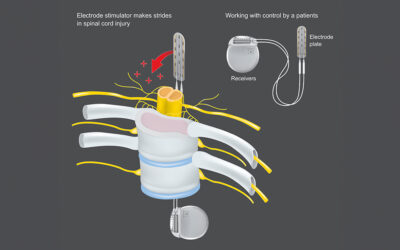Non-invasive treatments should be your first line of defense against neck pain.
Workouts, sports, and even sitting at a desk all day can put strain on the neck, leading to pain and discomfort. While some conditions may require orthopedic surgery, non-invasive treatments often lead to better long-term outcomes, and should generally be the first line of defense against neck pain.
A qualified physical therapist can help you create an appropriate plan for chronic neck pain, which is defined as pain that lasts for more than a few weeks. With a physical therapy plan tailored to your needs, you can safely gain strength and flexibility, as well as lower your chance of developing a future neck injury.
If you’re suffering from neck pain and looking to find relief, your physical therapist might suggest some of the following exercises.
1. SHOULDER AND HEAD ROLLS
These stretches are a good warm-up to start with before attempting other exercises. For a shoulder roll, keep your arms relaxed at your sides, and with your head upright, simply lift and roll your shoulders. Relax briefly between each roll. Do ten rolls forward, and ten back.
Before you try a head roll, stretch the neck. Make sure your shoulder blades are relaxed, and that your head is not tilted forward but sits directly over your neck. Start by dipping your chin slowly toward your chest, and hold for several breaths (if you are unable to dip your chin, or if it causes an increase in pain, stop and contact your doctor). Next, lift your head and lower your left ear toward your left shoulder, and hold. Repeat this movement on the right side, then do a similar stretch with your head tilted back.
After stretching your neck, you can roll your head slowly in sections, from tucked in front or tilted back toward each side, five times each. Avoid doing a full head roll, which can actually strain the neck.
2. SEATED NECK STRETCH
Deceptively simple, this exercise can even be performed at your desk. For a seated stretch, sit upright in your chair with your feet flat on the ground. Extend your right arm along your right side and place your left hand on the top of your head. Tilt your head to the left, applying pressure with your hand to gently intensify the stretch. Hold for 30 seconds, then repeat for the right side. You will feel this stretch in the levator scapula muscles in the sides of the neck.
3. WALL PUSH-UP
This exercise can help strengthen your shoulders and support your neck muscles, without causing as much stress as typical push-ups. Stand facing a wall, with two to three feet of space in front of you and your feet shoulder-width apart. Place your hands against the wall, just below shoulder level. Start with straight arms, and bend your elbows slowly to bring your body closer to the wall. Repeat this 10 times for one or two sets.
4. AQUATIC EXERCISES
While high-impact sports can be hard on the neck, low-impact sports like swimming, walking, or recumbent biking may help you avoid strain. If you have neck pain, many physical therapists recommend that you hit the pool for your aerobic exercises in order to increase blood flow to the neck.
While in the water, you can attempt neck flexibility stretches like the “clock” exercise. Repeat the following on both sides:
- Stand in a lunge position, with both arms at shoulder height. While the right foot and hand are forward at a 12 o’clock position, sweep the left hand back to 6 o’clock, following with the head and body. Repeat five times.
- Keep the left hand sweeping to 6 o’clock, while the head moves only to 9 o’clock, for five repetitions.
- For the last set of five, the head remains at 12 o’clock while the arm sweeps to 6 o’clock.
5. PRONE ROWS
This exercise strengthens the muscles that pull the shoulder blades together. You’ll want to lie facedown on a bed or similar surface, angled so that your face is in a corner, and you can dangle your arms off each side. Row upward, bending the elbows and squeezing the shoulder blades together without moving your head. Try about 20 repetitions for one or two sets. You can add light weights to this exercise if it is too easy.
EXERCISES TO AVOID
While adding these exercises to your routine, you should be careful to avoid workouts that may impede your progress. Don’t do sit-ups or crunches, as these can strain your neck vertebrae. In weightlifting, both the military press and lat pulldown put pressure on the vertebrae, and should be avoided.
The five exercises above can get you started on the road to recovery, although for best results, we recommend working with a physical therapist. If these exercises don’t relieve your pain, or cause pain that shoots into your shoulders or arms, contact a doctor as soon as possible. The orthopedic specialists at Comprehensive Orthopaedics can help you develop a personalized treatment plan and get back to the activities you love.



